
34 minute read
Message from the Headmaster
By Patrick Carruth
AS I REFLECT ON THE
PAST 12 MONTHS, I can truly say that this has been the most unexpected and difficult year of my career. Our administrative leadership, faculty, staff, and volunteers found ourselves in the position of re-inventing school, striving daily to educate our students in the best way possible in the midst of constantly changing circumstances, and they have done an amazing job.
Even as we strive to meet the challenges of the present, school leadership and trustees have been looking to the future, and we just released our Strategic Plan 2024, to guide the school for the next three years. Look for an article with more information about the Strategic Plan on pages 7 – 9 of this issue.
I am incredibly proud of our teachers and staff who remain steadfastly focused on our mission despite the many challenges posed by the pandemic. Their dedication, tenacity, resilience, and commitment both to students and to Christ, who is at the heart of our mission, continues to inspire me. Our families and students stepped up as well, partnering with us to follow the new protocols and guidelines that allow us to remain safely open for on-campus learning and to provide for students learning remotely as well. Faculty and staff have demonstrated grace and flexiblity through this year’s challenges while remaining focused on enabling students to become the individuals God intends.
If this past year has taught me anything, it has reminded me once again that I am not in control. Our God who is sovereign over all the earth has a plan for each of us, and we are to walk in faith, secure in the knowledge that He is leading us on the journey.
The Bear Creek School
STRATEGIC PLAN 2024

President and Headmaster Patrick Carruth sat
down recently with Andrea Lairson, Chair of the Board of Trustees at The Bear Creek School, to discuss Bear Creek’s Strategic Plan 2024. Andrea has served on the Board for over 20 years and as Chair for most of those years. In this article, Andrea and Patrick discuss a little bit of the history of strategic planning at The Bear Creek School, how the school has grown through strategic planning, and lessons learned along the way, particularly in these COVID-19 times. Patrick also details four distinct planks targeted in Strategic Plan 2024.
Andrea starts the conversation by reflecting that, “The last two strategic plans were really focused on building the Upper School, and that included a capital campaign, stewarding the permitting process, negotiating with the neighbors so that we could build, and then actually building the building.” Going back three or four strategic plans, having a school nurse was one of the goals. Andrea exclaims, “Who would have known that having a nurse as part of a strategic initiative would be so important!” For Andrea, what stands out from the prior strategic plan, Dare to Dream 2020, is the focus on integrating new technology into the classroom. This initiative meant that all the Middle School and Upper School teachers were trained on remote learning tools during the summer of 2019. So, Andrea remarks, “When COVID-19 hit in March 2020, the Middle School and Upper School teachers were already well on their way in preparation for remote learning.” Finances is another critical aspect of strategic planning, and Andrea shares that with the recommendation of Independent School Management, a well-regarded consulting and research firm, Bear Creek carries at least 20% of its operating budget in cash reserves. This is wise and strategic, providing the school with fiscal stability even in unforeseen situations. It is an important example of the ways in which Bear Creek’s proactive strategic planning has been critical during the pandemic. Andrea also describes how Bear Creek and its Christian identity are central to the school’s strategic planning. She states, “It is who we are, and that is not going to change. We have open enrollment, and so we believe in the power of the Holy Spirit to lead Christians to Bear Creek. But we also believe that God is at work in the lives of non-Christians, and non-Christians are welcome.” She explains further, “The mission is preserved through Bear Creek’s leadership and that, too, was a strategic decision that was made at the school’s founding and continues to be critical to Bear Creek’s future.”
Patrick adds, “I really appreciate the reminder of how God works through his people and how He has been working at The Bear Creek School for more than 30 years—through strategic planning and by having His hand on the school as we work in His kingdom to help students to become the individuals God intends.” He continues, “As we look to the future, our Strategic Plan 2024 is a three-year plan with four key planks: culture, people, program, and support.”
The CULTURE plank of the Strategic Plan encompasses our faculty and staff culture, as well as our broader school community. Our vision is to nurture a vibrant culture and community that attracts a wide range of missional faculty and staff and families, commits to care for all members as made in God’s image, and establishes The Bear Creek School as a recognizable asset in Redmond and the local community. Over the next three years, we will work to refine our current internal (faculty and staff) culture to deepen our values of mutual trust, innovation, predictability, and support, which translates into a continually improving student experience and increased satisfaction. This includes training faculty and staff in developing a leadership mindset to value cultural outcomes and systems of execution and accountability. Arising from our Northwest Association of Independent Schools (NWAIS) re-accreditation process, and a key component in our commitment to care, our No Ordinary People initiative grounds that commitment to care for our school community in the affirmation that each person unconditionally deserves love, dignity, and respect because all humanity has been created Imago Dei (in the image of God) and is one in that common creation. Further, the Scriptures command us to love the Lord and to love our neighbor, which encourages us to be wise and aware of the unique cultures He has created, to be compassionate by engaging diversity with dignity and respect, and by courageously centering our identity in Christ. These following strategies are central components of No Ordinary People: • Invest in parent volunteer training, workgroups, committees, presentations, and events and activities that provide avenues to learn about one another more deeply and celebrate the diversity of Imago Dei in the school community. • Expand our Community Partnership programs as part of our commitment to care and show compassion for others as made in Imago Dei, whether they are in our backyard or on the other side of the world. • Refine faculty and staff professional development for student care. • Implement student life curricula which train students to think biblically about loving one’s neighbor and showing dignity and respect to people in word and deed.
The vision for the PROGRAM plank is to elevate The Bear Creek School as a model for creative and innovative Christian liberal arts programming and to expand The Bear Creek School market in the local Redmond community and beyond. The pandemic has brought challenges but also given the school the opportunity to try new, innovative ideas and to think differently about how we approach our programs. We are excited to leverage what we learned this past year in ways that will benefit our current students and families as well as to offer a Bear Creek education to more families than was possible in the past. Our strategies to achieve this vision include: • Invest in innovative curricular and programmatic opportunities that enhance our existing curriculum.
• Leverage innovative practices and technology developed during the pandemic. • Foster an innovative mindset which leverages technology and creativity to improve efficiency and user experience related to business functions of the school. • Explore technology-enabled avenues for remote program delivery to new markets.
For the PEOPLE plank of the plan, our vision is to secure the mission of The Bear Creek School by making missional work a realistic possibility in the Redmond area, developing the future leadership of The Bear Creek School, and leveraging innovative lessons of the pandemic around staffing resources. We want to make Bear Creek a highly desirable place for people to come and work. Bear Creek faces a number of ongoing challenges in recruiting and retaining the best possible faculty and staff, among them the fact that this is an expensive area to live. Strategies for the People plank of the plan include: • Identify and develop the next generation of school leadership. • Establish intentional enrollment and employee targets which mirror the changing Eastside population, while maintaining and growing our classical and Christian distinctiveness. • Deepen and solidify the future of our classical and Christian educational model by creating a new faculty and staff onboarding program and continuing strategic professional development. • Create an active outreach plan to local, regional, national, and international communities which are missionally aligned to share best practices and skills. The SUPPORT plank of the Strategic Plan is focused on securing the future of The Bear Creek School through long-term planning for measured growth and fiscal stability. To achieve this vision, strategies include: • Create additional financial accessibility options to increase socio-economic diversification to support and enhance viability and our classical and Christian distinctiveness. • Continue to strengthen the culture of philanthropy at the school and build longterm support through planned giving and other donor-focused giving programs. • Complete the campus Master Plan through a Campaign Planning Study, and as warranted by the Study, conduct a philanthropic campaign to fund and build a new Athletics facility that will provide a high-quality and diverse athletics experience to Bear Creek students and families. • Increase employee salaries to the ninetieth percentile of the National Association of Independent Schools average and increase average benefits. • Create an active outreach plan to increase enrollment by connecting with local, regional, national, and international communities which are missionally aligned and not currently served by The Bear Creek School. As we look to the future, we invite you to spend a little bit of time on our Strategic Plan website TBCS.ORG/SP2024 for more details related to the planks described above.
ALLISON FLETCHER EXUDES JESUS’ LOVE AND EMPATHY IN HER P4 CLASSROOM DESPITE COVID OBSTACLES
On a typical day in Allison Fletcher’s prekindergarten classroom, she likes to gather the four-year-olds around on the floor. “I always say to my students, ‘When my hands are messy, my brain is working hard,’” Fletcher said, adding that handson learning is an exciting way for the kids to learn. “It’s really important for them to have their hands in things.”
But in the midst of a pandemic, that familiar, explorative way of learning had to be reworked. COVID-19 has changed the way teachers present in class, with some students in-person and others learning remotely from home. Fletcher has adapted her teaching to a blended classroom, learning to use various technology tools, such as Microsoft Teams and the OWL camera, so she can teach all of her students simultaneously.
Instead, she tells her students to hug themselves, give themselves a pat on the back, high five themselves, and remind themselves that Jesus loves them. The four-year-olds learn from distanced observation of each other, instead of close-contact interaction, but Fletcher still does her best to make
them passionate about learning in the classroom.
She quoted Ella Wheeler Wilcox, saying, “With every deed, you are sowing a seed, though the harvest you may not see.” Being a preschool teacher, she said, is just like sowing a seed, because although you don’t see the end result of their learning right away, eventually the foundation that she laid as their first instructor will grow.
Being a teacher was not originally in Fletcher’s plan, but when she began working at Bear Creek as an Office Assistant at the front desk in 2006 and saw the joy emanating from the preschool classroom, she was drawn to it. She returned to school to earn her teaching certificate, then joined the Preschool faculty.
Playing while also learning is the cornerstone of the prekindergarten curriculum. The teachers, Fletcher said, work diligently to create an environment where learning is fun. “Every time I
PHOTO BY LANA OZIK
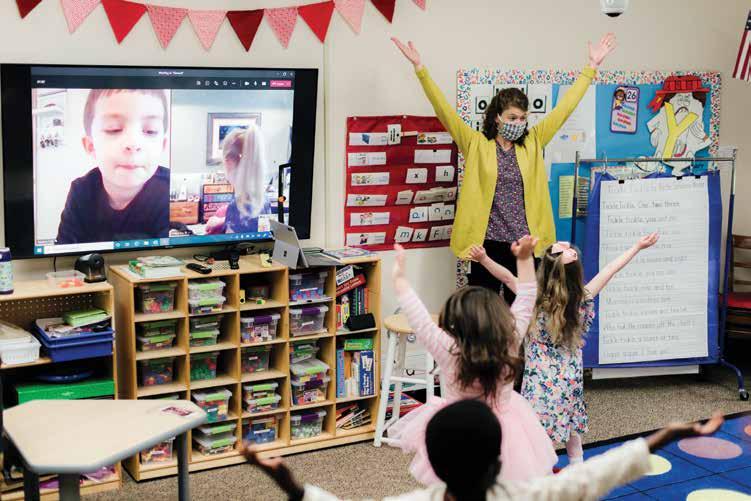
Allison leads her class in making Mr. Y, as part of their kinesthetic learning strategies. Students use their bodies and motions to help their brains make stronger connections and stay engaged.
would go into the preschool classroom, it seemed like everybody was just playing the entire time, but so much learning was happening,” Fletcher recalled. “I thought, this is such a dream job. You play with children all day long, and at the same time, you have such a great impact on them.”
When Fletcher first graduated from college, she wanted to work in the sports-related realm. She played nearly every sport growing up, sometimes two in the same season. She was so committed to sports that when she broke her nose in softball practice one day, she didn’t go to the hospital. Instead, she went to her next practice for her traveling soccer team and “handled my broken nose the following day,” she recalled with a laugh.
Allison is also a die-hard Green Bay Packers fan, and even owns a share of the team, which her husband gifted to her years ago. When she can travel again, she will most likely be setting off to see her favorite sports team in action. Although she does not play organized sports anymore, Fletcher remains incredibly active, going on daily walks and encouraging her students to move around in the classroom. “Children are active,

PHOTO BY LANA OZIK
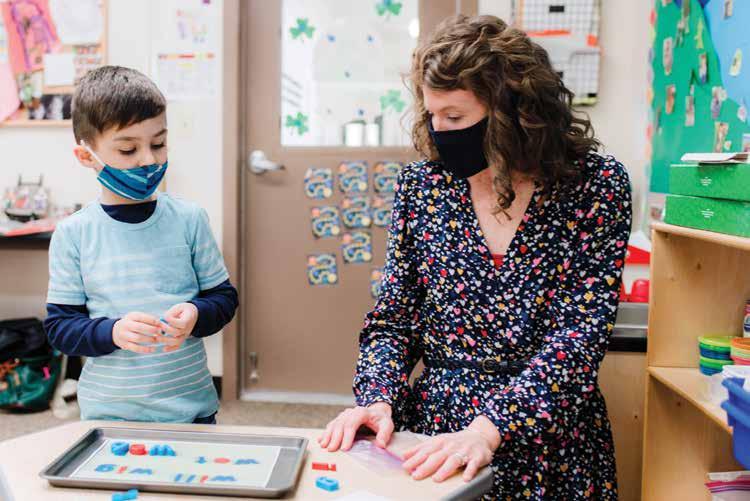
Build it, Read it, Write it with magnet letters on cookie sheets is a hands-on literacy game where students match the letters in each word, sound it out, and then write it on their dry erase board (depending on their level).
so it’s a great fit for who I am,” she said. “I have to be up and jumping and stretching and active all the time, so I always try to incorporate that into our school days, too.”
More than just a sports fanatic, Fletcher is also a mother of two children who attend Bear Creek. She believes that teaching is her life, as well as an immense privilege. “In this role as a teacher, you have to rely so much on Jesus and His plan,” she said. “It’s a humbling job and such an honor that someone would entrust you with his or her child, especially a preschooler, because it’s the first time the preschoolers have left home.”
Fletcher’s trust in Jesus exudes through her empathy in the classroom. She understands the different challenges students and their families can face because she has faced some of her own. Having been adopted as an infant and then later losing her adoptive parents, Fletcher understands loss. But she also knows what it’s like to gain family and feel nurtured—she reconnected with her birth parents later in life and was also welcomed in “with a ton of love” from her Bear Creek family, whom she refers to as her “friend-latives.”
“I think all of that has given me a lot of empathy for challenges that families will have at school,” she said. “That journey helped me solidify my own faith through those trials.” Not only did she stumble upon a secondary family she never knew she needed, but she also saw the plan Jesus had in store for her. “The most valuable thing is that it’s such a family at school,” she said. “I feel like I’ve been adopted twice. Once as an infant, and then I joke sometimes that I was adopted a second time at Bear Creek.”
THE BUILDING OPERATIONS TEAM KEEPS THE SCHOOL SAFE AND RUNNING SMOOTHLY
BY JANEEN SORENSEN
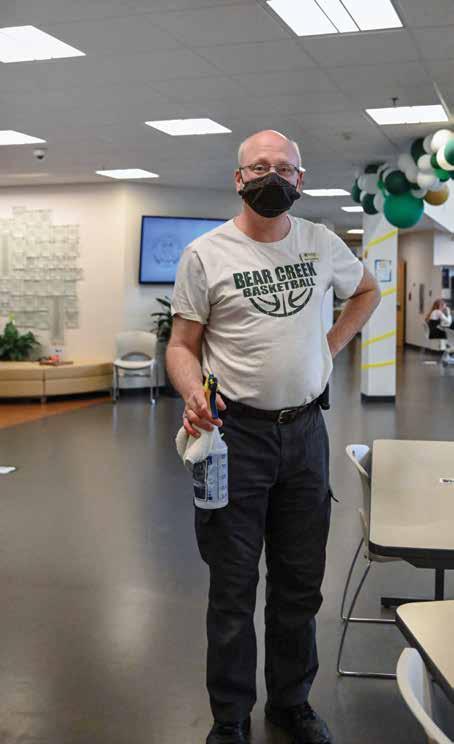
One might think of the Building Operations team at The Bear Creek School as the helpful guys who open and prepare the buildings each day, change the lightbulbs, fix leaky toilets, and set up and tear down our events—the tasks that keep our buildings operating and safe each day. While this is all true, in light of COVID-19, safety has become a primary responsibility. Here is a glimpse into what a day looks like on each of our campuses for three of our Building Operations staff.
PHOTO BY CINDY MCCAHILL
Mark Schnarre keeps tables clean in the Upper School’s Nagel Commons.
A DAY IN THE LIFE OF OUR BUILDING OPERATIONS STAFF
5:40 A.M. Mark opens the Upper School gates for the day and checks them for any signs they need repair. Then he walks around the building and makes sure all the exterior lights are working. On his walk, he collects any litter in the drop-off and pick-up area in front of the building. As Mark turns on the hose to supply more water to the Upper School fountain, he notices the connection is leaking and looks like it may have been stepped on. He makes a note to source a new hose splitter. After checking the outdoor areas, Mark stops in his office, where he outfits himself with a mask and the supplies he routinely uses, including Upper School building keys, his name tag, phone, a multi-tool, flashlight, ink pen, Sharpie pen, and blue tape. He then moves through the interior of the Upper School building, listening for the sound of alarms, dripping water, or buzzing lights. He looks for lights that are not working, doors that should be propped open,
David Dodson is part of the Building Operations staff at the Redmond Campus Main building. He grew up in Bellevue and has a Bachelor of Arts in education from Eastern Washington University. Dave has been a member of the Building Operations team since 2013 and is one of our thoughtful and intentional Middle School basketball coaches. When Lower School students see him in the halls, they can be overheard saying, “Hi, Mr. Dave!” Dave says, “One of the special moments of my day is connecting with the students and hoping to share a little with them of who I am or what the Lord is doing in my life and work at the school.” Thomas McKinnon is the primary contact for Building Operations at our Valley Campus, home of Bear Creek Preschool. He has been part of the Building Operations team since 2015. He enjoys variety and has worked in various roles at all our buildings. Tom says his favorite part of working at Bear Creek is driving a bus for student field trips and athletics events “all over the state—especially last year’s run during the State basketball tournament!” He enjoys being called Mr. Tom, Mr. T, and Mr. Fixit by both staff and students. Outside of work, he and his wife, Kristin, love raising their four children in Snohomish and taking them on beautiful road trips across the country. Mark Schnarre has been a member of the Building Operations staff since 2001 when his wife Jacky Schnarre, grades 3 through 6 Science Specialist, mentioned that Bear Creek was looking for a night custodian and bus driver. Mark worked nights and then evenings for several years including two years at Valley Campus. Now Mark is the primary Building Operations staff for day-to-day maintenance at the Redmond Campus Upper School building. Mark’s and Jacky’s two sons, Benjamin ’21 and Levi ’23, have been students at Bear Creek since kindergarten.
items for lost and found, or any warmthloving insects or other creatures that somehow found a way indoors.
6:30 A.M. Dave arrives on campus, unlocking the Main building gates and making a slow drive around the school, checking for lights that need replacing and anything that seems out of place. He makes sure the traffic cones are out and in the correct places and turns on the lights in our three outdoor tents. Once inside, he turns on all lights in the main halls upstairs and downstairs, band hallway, administration offices, and at the front desk. Along the way, he unlocks the work rooms upstairs and downstairs. He props open any interior doors to eliminate unnecessary touching of door handles throughout the day, and brings in any packages left outside the front door the previous evening. 7:00 A.M. Back in his office, Mark checks his email for any maintenance or Fixit requests that may have been sent overnight. Fixit tickets are generated by a request submitted via email from faculty or staff requesting help from Building Operations with a project or task. Fixits can cover a wide variety of things including PPE requests, replacing a classroom clock or light, changing batteries, and raising or lowering desks depending on a student’s preference and physical growth during the year. There are also the messier urgent requests such as clogged toilets or water on the restroom floor or cleaning up after a student gets sick or suffers a bloody nose. Today there is a request for extension cords in the classrooms for student Surfaces that need charging before the end of the day. There is also an email to review the suggested location for a new picnic table.
Simultaneously, Tom arrives at the Bear Creek Preschool’s Valley Campus, where he opens the driveway gate and rolls back the chain link gate to the faculty and staff parking lot and checks the dumpster area. He takes a few minutes to search for any trash in the west parking lot, then begins to unlock the bathroom and classroom doors while turning on lights as he goes. He checks that all of the classrooms were cleaned, and the garbage cans were emptied by the janitorial staff the night before. Once at his desk, he reviews his email for any issues that may have come up overnight.
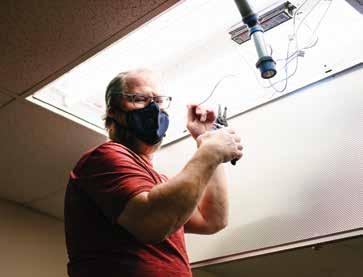
7:30 A.M. In his office, Dave checks email and reviews his calendar for any events today that may need attention. It is a quiet day like most this year because many on-campus events have been reimagined online. If there were an event, he would check the Event Request Form (ERF) for the location, number of tables and chairs, and requested seating style and make plans to set up. He then turns his attention to completing his open Fixit tickets. 7:45 A.M. Before the students arrive, Tom walks around Valley Campus, checking for cobwebs and spiders on the metal fences near the parking lot and student entrance. He sweeps up any debris or scattered stones on the sidewalks. In the main office, he checks the thermostat and peeks in at the kitchen for any messes that need attention. Tom starts the leaf blower to remove bark, leaves, and debris in the breezeway, then all the sidewalks, steps, and gravel paths. He straightens up the bark under the large willow tree and completes his circuit by blowing off any debris in the entrance driveway and parking lots, so the campus is clean and neat when the preschoolers begin arriving later in the morning.
8:05 A.M. Upper School classes have started, and students are on campus for the day. Mark walks through the building disinfecting the doors and other high touch areas. This is the first of three disinfection rounds for the day which take about 45 minutes each.
8:45 A.M. Preschool students are arriving in their classrooms, so Tom returns to his office, checks his
Dave Dodson changes a balast in the overhead lighting at the Main building.
messages, while being ready to tackle any last-minute needs that may arise during drop-off. There are a variety of tasks each day such as cleaning cubby tops outside the classrooms, wiping down windows, removing standing water on the breezeway, and occasionally retrieving an escaped chicken when the students are learning about the life cycle of a chicken. This morning, he takes a few minutes to help Denise Peeler, who runs the Discover and Investigate God’s Creation (DIG) program, bring in supplies from her car for class.
9:00 A.M. Mark keeps an eye out the window for vendor trucks or large deliveries. Today he meets with the HVAC technician to explain an issue with Roof Top Unit #2. 9:30 A.M. After the Main building drop-off finishes, Dave checks and refills the disinfectant bottles and hand sanitizer stations located in entry and high traffic areas throughout the building. He checks in with the other Building Operations team members to catch up on what their workloads look like today and see if they need to shift responsibilities around to assist each other.
Mark fills a crack in the Performing Arts Center floor. He also checks on his Kenwood two-way radio to make sure it is charged and ready for incidents like an earthquake, fire, lockdown, or any other emergency on campus. Mark mentally walks through what the
Tom McKinnon checks construction of the playhouses at Valley Campus.
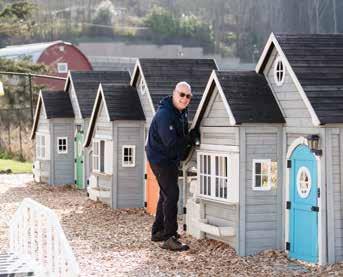
response would look like if a significant earthquake struck right now. While COVID-19 procedures have taken a primary role this year, our Building Operations team continues to work hard to ensure the safety of our students during an emergency.
9:45 A.M. It takes two members of the Building Operations staff to disinfect the bathrooms and high touch point areas throughout the Main building. Each morning Dave tackles the bathrooms by spraying disinfectant on all toilet seats and urinals, sinks, door handles, locks, and other high touch areas. He lets the solution sit for five minutes and then wipes everything down.
10:00 A.M. Preschool recesses start. While each of the classes rotate onto the Valley Campus playground for the next hour, Tom checks the water levels on the portable sink reservoirs in the empty classrooms and refills as needed. He sprays disinfectant and wipes down all high touch areas in the classroom such as the student desks, backs of chairs, counters, and door handles. He also disinfects the breezeway bathrooms, classroom exterior doors, hand sanitizer stations, and breezeway railings.
10:15 A.M. The Upper School students finished their break, so Mark walks through the building disinfecting the doors and other high touch areas like the doorknobs, chairs, and tables. He starts to plan garbage can dispersal based on grade-level room assignments in preparation for lunch. 10:30 A.M. Dave checks the janitorial supplies in the stockroom to ensure there are enough touchless paper towel rolls, hand soaps, toilet paper, and other supplies to support our janitorial staff. Part of his job is to manage the inventory and submit an order for approval by Building Operations Manager Nathan Foshee. On occasion, he makes a run to Home Depot or Batteries Plus Bulbs for an immediate need. 10:50 A.M. Lunches are starting, so it is time to move garbage cans into position. Dave places cans in the Lower School hallways. The rolling 40-gallon garbage cans allow students to throw out their lunch garbage and not overfill the classroom trash cans. After lunch ends for the younger students, Dave redeploys the garbage cans upstairs for grades 5 – 8 classes to use. Mark moves the garbage cans into the Marilyn R. Nagel Commons and in the hallways outside the classrooms. He then fills the mop bucket with disinfectant for the tables in the Nagel Commons in preparation for clean up after lunch. 11:00 A.M. Now that Preschool students have finished using the Imagination Lab for the day, Tom sprays and wipes down the manipulatives, interior surfaces, and all doors. In the Little Gym, he sanitizes all floor mats, climbing racks, moveable blocks, rolling carts, and anything else the students may have played with throughout the day. He also disinfects the interior doors and exterior access doors throughout Valley Campus.
12:15 P.M. Dave takes a half-hour break for lunch, checks his email, and reviews any Fixits that have come in from teachers or staff. Today he has a Fixit request for an extra desk in the hall for a student to work at if needed and for one-on-one assessments with their teacher. Another Fixit requests special rug tape to remove the wrinkles in the middle of a Lower School classroom rug that is creating a potential tripping hazard.
12:30 P.M. Valley Campus is starting to shut down for the day. After a quick lunch, Tom checks and tops off all portable sink water reservoirs in the
classrooms, then tackles his larger projects and Fixits for the day, including repairing some light fixtures. He also maintains all the landscaping, which can range from trimming the bushes to raking errant leaves. This afternoon he plans to cut the lawns and weed whack the natural growth areas.
12:45 P.M. Dave and Mark collect the garbage cans from lunch and transfer the garbage and recycling to the outdoor containers, then replace the liners in preparation for tomorrow. 1:00 P.M. Each afternoon Dave disinfects the high touch areas throughout the building including disinfecting all door handles from the classrooms to the administration offices, push bars on the external doors, light switches, seat cushions in the main hallway, desks in the hallways, railings on the staircases, the telephone in the hallway outside the gym, and the intercom button for the front entry door.
1:15 P.M. Back in his office, Mark now has some time in his day for special projects. Distance and spacing are very important, so to demonstrate sixfoot spacing in the classrooms, he has made floor plans of the classrooms in Microsoft Visio with appropriately spaced six-foot circles. Today he works on refining those drawings. He also has the opportunity for 3D printing objects for furniture and fountain repair.
2:00 P.M. It is time for the weekly Facilities meeting to review what has happened this week, get updates from the administration or teachers, and go over any big upcoming events that need more detailed planning.
2:30 P.M. In the last half hour of the day, Dave checks for any new Fixits and emails to make sure he has addressed everything that needs attention before he leaves. He checks in with Nathan to update him on the day’s events and see if there are any vendors that will be on campus tomorrow. Mark finishes the final tasks of the day and as he heads home at 3:00 p.m., turning his thoughts to planning what to cook for dinner tonight.
SAFETY PROTOCOLS WITH NATHAN FOSHEE
Before students started to return to campus last fall, Building Operations Manager Nathan Foshee, in conjunction with Health Services Manager Lea Hysom, worked to create a comprehensive cleaning and disinfecting plan that followed the guidance of Seattle King County Public Health as well as the more global recommendations put forth by the Washington Department of Health and the Centers for Disease Control and Prevention (CDC). After the plan was developed, Nathan states, “Our Building Operations team took on numerous additional daily responsibilities to assist with the new protocols and have been working tirelessly to ensure their success.” The team took stock of any high-touch area, which is any area or item that multiple people come in contact with throughout the day. The Building Operations staff utilizes a modified airless paint sprayer filled with an EPA-approved disinfectant. According to Nathan, “We spray entire bathrooms every two hours and allow the disinfectant to evaporate properly before re-opening them. For other high-touch areas such as doorknobs and counters, we spray disinfectant and wipe them clean every two hours.” Each evening, the janitorial staff utilizes their own sprayers to clean and disinfect every classroom as well as common areas. Another critical piece of the Bear Creek safety measures is managing air filtration and fresh air cycling into the building and classrooms. Over the summer, Nathan worked very closely with our heating, ventilation, and air conditioning (HVAC) vendor to have air balance testing completed on the
3:15 P.M. Tom starts wrapping up his day and checks for any teachers remaining on campus to let them know they will soon be responsible for locking the gates if they are planning on staying any later. He is looking forward to hearing about his children’s day when he gets home.
Dave, Mark, and Tom were all quick to mention that seldom do the days as part of the Building Operations staff follow typical or routine patterns. The new COVID-19 safety measures and procedures provide a consistent framework for the day, but as Dave explains, “Things can change on a daily basis, and never is one day similar to the next.” All three would likely agree that this constantly shifting mixture of tasks and projects make for an interesting day filled with variety.
While Dave, Mark, and Tom are key personnel of the Bear Creek Building Operations team, they are not the only members in this tireless crew. Nathan Foshee oversees the COVID-19 safety protocols and also manages vendors. Michael Riley manages the scheduling and set-up requirements for events as well as coordinating transportation off campus. He researched and set up the sanitizer stations, procured new furniture like individual desks for this school year, and sources and manages our personal protective equipment (PPE). Paul Holeman takes care of much of the outside upkeep and improvement at our Redmond Campus including the new walking trail and field to the north of our Main building. Adam Johnston worked to set up the 6-foot spacing in our classrooms, placed the sticker distance reminders in the hallways and outdoors, and supports Dave with disinfecting and sanitizing. Jimmy Quinonez oversees the janitorial work and deep cleaning each night after the students and staff have left for the day. The Bear Creek School is grateful to the entire Building Operations team for their dedication to keeping everything running smoothly, helping our faculty, staff, and students stay healthy and safe, and maintaining our beautiful campuses.
units for our buildings. Our vendor improved our units to bring the maximum amount of outside air into the buildings through air exchanges every ten minutes. As Nathan explains, “This is the best thing to prevent COVID-19 spread in a large building; coupled with the masking, social distancing, and disinfecting protocols we have in place.” The Upper School building also switched to Minimum Efficiency Reporting Value (MERV) 13 filters. The MERV 13 rating means the filter is 90 – 98% efficient at capturing particles. The higher the rating, the more efficient the filter and the more particles it can filter. The windows in the Upper School classrooms also open to allow for more airflow. Over Mid-Winter Break, the school replaced the HVAC system in the Main building to a MERV 13 unit. The windows open in the preschool classrooms at Valley Campus, allowing adequate fresh air to circulate without the need for additional filtering. In addition to these changes and upgrades, Nathan notes, “I take numerous air quality readings around the buildings at the start of each week to monitor different metrics. I take note of carbon dioxide outputs to make sure they fall within a range appropriate for the size of the room and occupancy.” The testing consistently verifies low carbon dioxide outputs, which indicates that the HVAC improvements and open windows are successfully increasing fresh air flow into our buildings and classrooms.
What do teens of today think about? What affects our youth so profoundly it alters the way they think, the lens they look through, and the art they create?
This combined exhibition by eight Advanced Studio Art students featured the works of seniors, each a passionate student-artist exploring his or her thoughts through visual form. Read excerpts below, or for complete statements about their work, see the post on our Bear Creek Blog at www.tbcs.org/blog.

UNCONDITIONAL LOVE
By Katelyn Britney
I believe animals have a very important role in our world. They bring a different light that people do not necessarily possess. When people say a dog is a “man’s best friend,” I believe it to be true. Dogs understand you at a different level, comfort, and will listen when no one else will. It brings me great sorrow seeing these hopeful, loving dogs on the street with nowhere to go and no one to love. They can look gruffy on the outside, but their appearance shouldn’t matter. Unfortunately, it is quite common for a dog to go throughout their whole life without ever finding “their” person or source of companionship.

LIFT OFF
By Eleanor Carruth
No matter what stage of life we are in, we are growing, learning, and changing. I have always felt an unprecedented gratitude to people in my life and to God for giving me the ability to explore and express what I wish. The freedom to speak, think, learn, and act the way I choose is something that I am forever grateful for.
So, I chose to focus on depicting birds. Together, they are the paragon of freedom, but as individuals they also present pieces of my person: Spring, Scotland, and the Swallow.
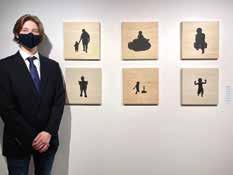
IN THE BLINK OF AN EYE
By Parker Jani
Life is difficult. Life is unpredictable. Life rarely goes where you expect it to. My life has been nothing short of these descriptors. Like many I have lived through astounding highs and tremendous lows. I have experienced feelings so great I could not even begin to describe them, and feelings so dark I wish no one would ever have to experience. I have had moments where I have never felt more alive and times spent wondering if this moment or the next is when I will die. ... However, in some odd way, through all the trials and tribulations I have experienced I have come to realize life is the most beautiful thing the world has to offer.

HOME IS ALWAYS HOME
By Khanh Le
Home always waits for us. Despite traveling thousands of miles and through all the changes, home is always home. Adjusting to a new city, community, and school was a challenge because I was used to being in Vietnam, with my old friends, at my old school. ... As an international student with no friends who speak the same mother language, I experienced a loneliness that grew in time. I found solace in my video calls with my family in Vietnam. They would never fail to let me know that despite being on two different continents, they will always be there for me.
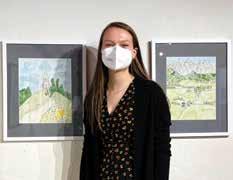
COUNT IT ALL JOY
By Claire McArthur
sidewalk, my ponytail swooshing from one shoulder to the other. Back and forth. Back and forth. My shoes slapped on the pavement as I gazed up at the trees and sunny spring sky. Despite being sweaty, sore, and sick of the same old routine, I had begun to find a certain hidden joy within runs through my neighborhood. They soon became a staple of my spring and summer of 2020 as I relished the moments away from my desk as I focused on the simple breeze blowing through my hair. Such afternoon runs led me on a journey to joy.
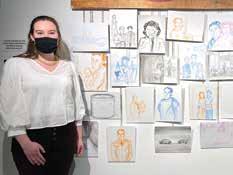
TABLE OF CONTENTS
By Kate McDonough
Every individual has a beginning, middle, and end. People have a story, full of climax or anticlimactic instances, innocence and hardship, joy, and sorrow. Each of our stories are just as diverse as each person is individualistic. However, we all share the commonality that our stories are what shape and inform us. ... We all have stories, good and bad, for better or for worse, that provide context and insight as to where we are from, where we are, and where we will go.

THE FULLNESS OF LIFE
By Zoe Osborn
Whether you are a coffee or a tea person, or maybe both as I am, you will understand that a good beverage can make your day that much better. When we miss that special morning drink, we can feel like our day didn’t start out on the right foot; something feels missing and we are not completely satisfied. In a similar way, life can sometimes leave us wanting more, leading us to desperately try and fill our lives with things we think will satisfy us.
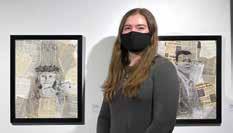
VOICES OF HOPE
By Lily Parker
History is written by the victors, the powerful, the mature. But what would a child tell us about being sieged by the Nazis, or marching for civil rights, or carrying tradition forward? We always look to the leaders for the story, when truth can also be found in the small and the innocent.








